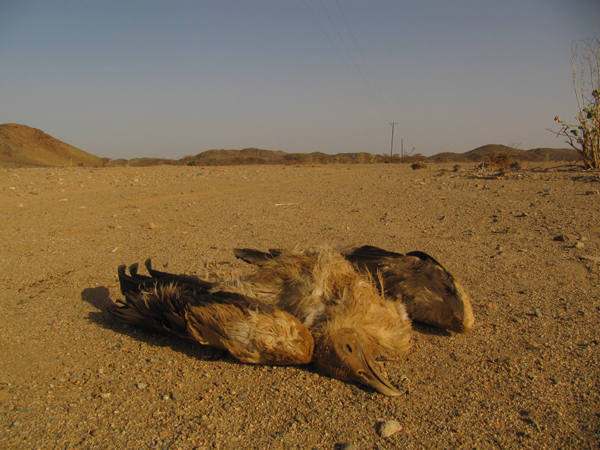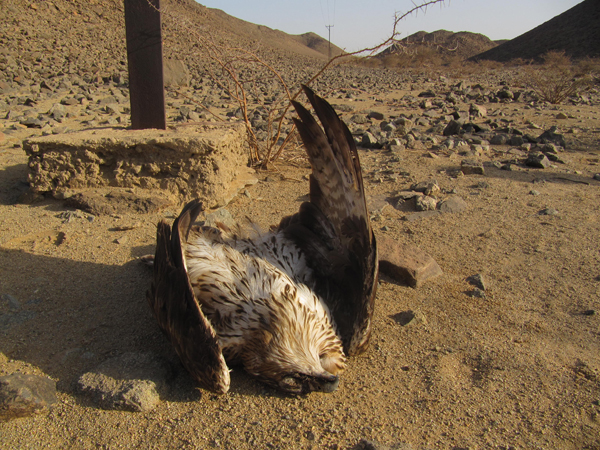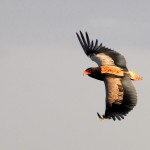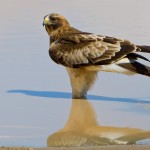A death trap for Egyptian Vultures in Africa – by Ivailo Angelov and Ibrahim Hashim
A joint expedition between BSPB (Bulgarian Society for the Protection of Birds) and the Sudanese Wildlife Society (25.IX-5.X.2010) has found 17 electrocuted Egyptian Vultures. The main study area of the expedition was the Red Sea coast in North-Eastern Sudan.

The finding of the dead birds under a particular power line in the surroundings of Port Sudan confirms a major threat to raptors there which has long been known to cause mortalities of many birds. During German ornithologist Gerhard Nikolaus’s expedition in 1982-83 found nearly 55 electrocuted Egyptian Vultures under the same power lines and during his next visit in the area 21 years later, he found another 5 dead birds. Until now there are almost 80 electrocuted Egyptian Vultures but this is only the tip of the iceberg since the power line was built in the 1950s and has probably caused the death of hundreds if not thousands of Egyptian Vultures.

In the past, the area around Port Sudan was the most significant known stop-over site of the species in Sudan during its autumn migration from Eurasia. But in spite of this, the expedition which was conducted during the peak of the palearctic migration found very low numbers of Egyptian Vulture This study not only found dead Egyptian Vultures, but also Lappet-faced Vultures, Steppe Eagles and also an electrocuted Bonelli’s Eagle, most likely from a nearby territorial pair which was previously not known to occur in Sudan.
The high mortality during the migration and in the wintering sites is considered to be one of the main reasons in the myriad of threats leading to the rapid decline of populations of Egyptian Vultures in the Balkans. Data from long-term monitoring in Bulgaria and Macedonia over the last 8 years, has shown that during the spring, significant populations of the birds do not return to their breeding territories. It is well known that often during migration and wintering, Egyptian Vultures prefer to roost on electrical poles and pylons. The power line causing the death of so many of these endangered vultures is situated close to big farms that attract many birds and cover an area of a several square kilometers. Ironically, until last year, this was the only power line going out of Port Sudan and offering an attractive roosting site for the birds.
This power line supplies electricity and ensures the work of pumps in the water supply zone which provides water to almost 500 000 inhabitants of the town. We assume that decades of such impact on the species caused by this single extremely dangerous power line may have been responsible for causing large scale mortalities of Egyptian Vultures. The species traditionally migrates along the western Red Sea coast and breeds in Eastern Europe, Western and Central Asia and the Middle East. Following the results from this expedition, a critical priority for halting these mortalities will be the insulation of the dangerous power line near Port Sudan and convincing of the Sudanese Electricity Company to use a safe model of pylons. It is still not known whether the Bulgarian birds use this migratory route but we hope that the future research using satellite telemetry will reveal more and will assure a better planning of the conservation measures which invariably will need to cross the national borders.
We thank the Sudanese Wildlife Administration for assuring the safe implementation of the expedition. For the financial support we thank to African Bird Club, Mohamed bin Zayed Species Conservation Fund, Stitching Vulture Conservation Foundation and the Royal Society for the Protection of Birds, UK.




Thanks for sharing this. This is really bad news but probably only the tip of the iceberg.
Are there any chances that the powerlines can be made secure in the future?
Thank you for your important work, which has wide ramifications.
How do powerlines get insulated? – Is it standard practice now?
Are the pylons used nowadays safer – what is a safe pylonw?
@Anne: There are several ways today to make powerlines safe.
In Germany a law requires the energy companies how to make powerlines and poles safe for birds until 2012.
There are good and bad solutions. A good solution is to put isolating covers on the poles. They should last as long the the poles themselves and big enough to make it safe for very big raptors like White-tailed Eagles which have a wingspan of up to 245cm.
There are also many bad solutions. Often steel bars are put 50cm about the pylon so that raptors perch there. But many smaller raptors like Common Buzzards or Common Kestrels often perch below the steel bar directly on the pylon.
More information can be found here:
http://www.nabu.de/tiereundpflanzen/voegel/forschung/stromtod/05166.html
If you scroll down, there is also a list of PDFs in various languages with more details.
If you can read German, I highly recommend a recently published book about the subject which can be found here:
http://birdsandpowerlines.org/
One thing has to be kept in mind. No pylon or line is 100% safe. Even if it is completely isolated, birds can still fly against the wires (a serious problem for some species, for example bustards, but also raptors).
The best solution is to put the powerlines in the ground which is increasingly done in Germany and other parts of Europe.
Markus
Now we are working in Sudanese Wildlife Society to put a plan together with electricity administration towards conserving migratory birds especially raptors by shifting the old power-lines with new safe ones or to put isolating covers.
[…] be one of the main reasons leading to their rapid decline. In the early 1980s, German ornithologist Gerhard Nikolaus found nearly 55 electrocuted Egyptian Vultures under a particular 31-km long power line in the […]